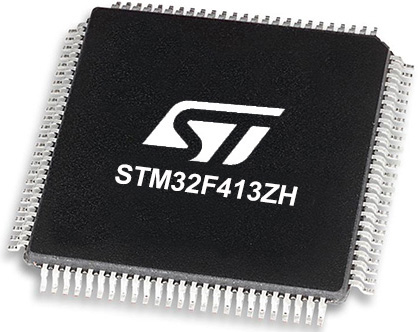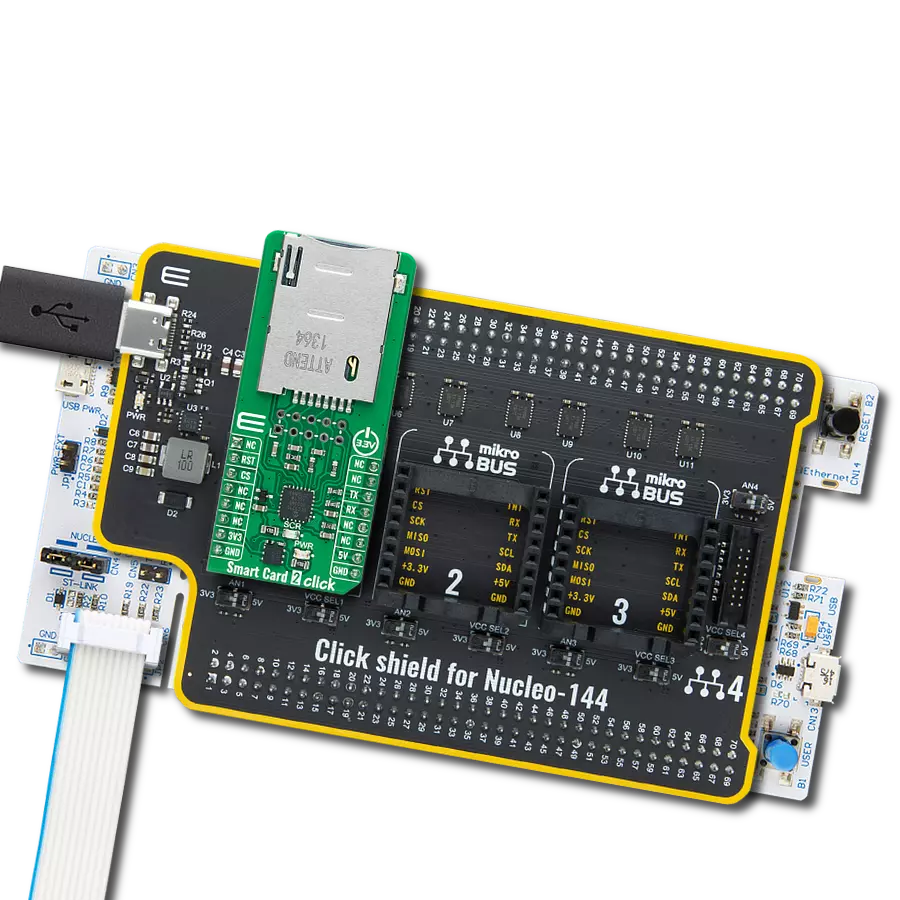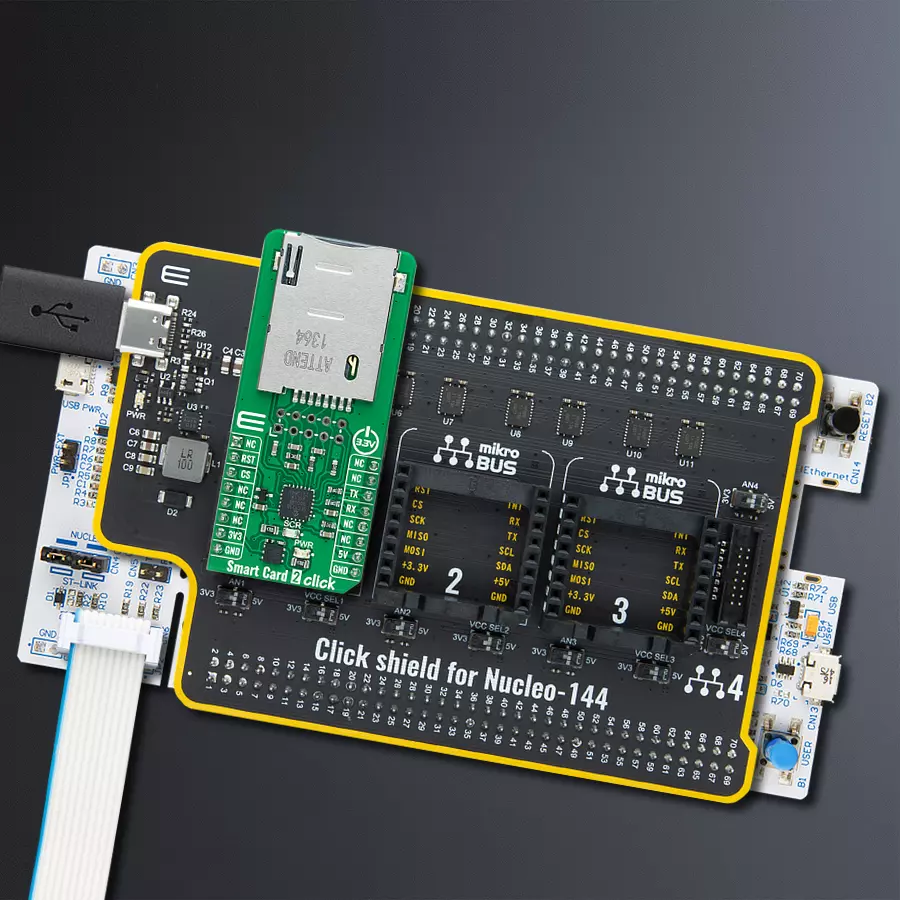Explore the most advanced smart card reader on the market, offering unparalleled protection and ease of use
A
A
Hardware Overview
How does it work?
Smart Card 2 Click is based on the SEC1210, a high-performance single-chip Smart Card controller with a UART interface from Microchip. The SEC1210 is controlled by an enhanced integrated 8051 CPU, with all chip peripherals accessed and managed through the SFR or XDATA register space. Besides, it is fully compliant with the prevailing Smart Card standards (ISO7816, EMV, and PC/SC), keeps up with all requirements for communication bit rate, and includes support for proposed bit rates up to 826Kbps. The SEC1210 power unit is regulated and switched internally, supporting all 5V, 3V, and 1.8V Smart Cards (classes A, B, and C, respectively). The SEC1210 utilizes TrustSpan™ technology, enabling digital systems to communicate securely, process,
move, and store information. A populated onboard card holder supports data processing with 2FF smart cards. An additional connector for external connection also allows the processing of a standard 1FF card, making it ideal for electronic processes such as personal identification, access control (physical and logical access), authentication, and many more. This Click board™ communicates with MCU using the UART interface with commonly used UART RX/TX and operates at 115200 bps by default configuration to transmit and exchange data with the host MCU. The sequence activation/deactivation process itself is possible through software. Still, hardware deactivation is also supported when a card is
pulled out, whereby the required sequence is ensured regardless of software participation. In addition, Smart Card 2 Click also possesses a general Reset feature routed to the RST pin on the mikroBUS™ socket, which puts the module into a Reset state, while a yellow LED indicator labeled SRC represents a Smart Card status indicator. The blinking of this LED indicates that the Smart Card data processing is in progress. This Click board™ can operate with 3.3V and 5V MCUs, while SEC1210 uses only 5V from mikroBUS™ power rail as its primary power supply. However, the Click board™ comes equipped with a library containing functions and example code that can be used as a reference for further development.
Features overview
Development board
Nucleo-144 with STM32F413ZH MCU board offers an accessible and adaptable avenue for users to explore new ideas and construct prototypes. It allows users to tailor their experience by selecting from a range of performance and power consumption features offered by the STM32 microcontroller. With compatible boards, the
internal or external SMPS dramatically decreases power usage in Run mode. Including the ST Zio connector, expanding ARDUINO Uno V3 connectivity, and ST morpho headers facilitate easy expansion of the Nucleo open development platform. The integrated ST-LINK debugger/programmer enhances convenience by
eliminating the need for a separate probe. Moreover, the board is accompanied by comprehensive free software libraries and examples within the STM32Cube MCU Package, further enhancing its utility and value.
Microcontroller Overview
MCU Card / MCU

Architecture
ARM Cortex-M4
MCU Memory (KB)
1536
Silicon Vendor
STMicroelectronics
Pin count
144
RAM (Bytes)
327680
You complete me!
Accessories
Click Shield for Nucleo-144 comes equipped with four mikroBUS™ sockets, with one in the form of a Shuttle connector, allowing all the Click board™ devices to be interfaced with the STM32 Nucleo-144 board with no effort. This way, MIKROE allows its users to add any functionality from our ever-growing range of Click boards™, such as WiFi, GSM, GPS, Bluetooth, ZigBee, environmental sensors, LEDs, speech recognition, motor control, movement sensors, and many more. Featuring an ARM Cortex-M microcontroller, 144 pins, and Arduino™ compatibility, the STM32 Nucleo-144 board offers limitless possibilities for prototyping and creating diverse applications. These boards are controlled and powered conveniently through a USB connection to program and efficiently debug the Nucleo-144 board out of the box, with an additional USB cable connected to the USB mini port on the board. Simplify your project development with the integrated ST-Link debugger and unleash creativity using the extensive I/O options and expansion capabilities. This Click Shield also has several switches that perform functions such as selecting the logic levels of analog signals on mikroBUS™ sockets and selecting logic voltage levels of the mikroBUS™ sockets themselves. Besides, the user is offered the possibility of using any Click board™ with the help of existing bidirectional level-shifting voltage translators, regardless of whether the Click board™ operates at a 3.3V or 5V logic voltage level. Once you connect the STM32 Nucleo-144 board with our Click Shield for Nucleo-144, you can access hundreds of Click boards™, working with 3.3V or 5V logic voltage levels.
Used MCU Pins
mikroBUS™ mapper
Take a closer look
Click board™ Schematic

Step by step
Project assembly
Track your results in real time
Application Output
1. Application Output - In Debug mode, the 'Application Output' window enables real-time data monitoring, offering direct insight into execution results. Ensure proper data display by configuring the environment correctly using the provided tutorial.

2. UART Terminal - Use the UART Terminal to monitor data transmission via a USB to UART converter, allowing direct communication between the Click board™ and your development system. Configure the baud rate and other serial settings according to your project's requirements to ensure proper functionality. For step-by-step setup instructions, refer to the provided tutorial.

3. Plot Output - The Plot feature offers a powerful way to visualize real-time sensor data, enabling trend analysis, debugging, and comparison of multiple data points. To set it up correctly, follow the provided tutorial, which includes a step-by-step example of using the Plot feature to display Click board™ readings. To use the Plot feature in your code, use the function: plot(*insert_graph_name*, variable_name);. This is a general format, and it is up to the user to replace 'insert_graph_name' with the actual graph name and 'variable_name' with the parameter to be displayed.

Software Support
Library Description
This library contains API for Smart Card 2 Click driver.
Key functions:
smartcard2_send_ccid- This function sends the CCID command message by using UART serial interfacesmartcard2_read_ccid- This function reads a CCID response or event message by using UART serial interfacesmartcard2_icc_power_on- This function activates the card by performing an ICC power ON command. The device will respond with a data block containing ICC ATR (Answer to Reset) message
Open Source
Code example
The complete application code and a ready-to-use project are available through the NECTO Studio Package Manager for direct installation in the NECTO Studio. The application code can also be found on the MIKROE GitHub account.
/*!
* @file main.c
* @brief Smart Card 2 Click Example.
*
* # Description
* This example demonstrates the use of Smart Card 2 Click board by checking
* the SIM card presence and activating the card on insert. The card should respond
* with an ATR (Answer to Reset) message.
*
* The demo application is composed of two sections :
*
* ## Application Init
* Initializes the driver and enables the device.
*
* ## Application Task
* Reads and parses all CCID messages received from the device. Checks the SIM card presence
* and activates it if it's inserted. The card should respond with an ATR (Answer to Reset) message.
* All data is being logged on the USB UART where you can track their changes.
*
* @note
* This example doesn't parse ATR messages.
* There are some online ATR parsers which could be used for decoding those messages.
* For example: https://smartcard-atr.apdu.fr/
*
* @author Stefan Filipovic
*
*/
#include "board.h"
#include "log.h"
#include "smartcard2.h"
static smartcard2_t smartcard2;
static log_t logger;
static uint8_t icc_status = SMARTCARD2_ICC_ABSENT;
/**
* @brief Smart Card 2 display ccid message function.
* @details This function parses the CCID message and updates the icc_status in the end.
* The results will be displayed on the USB UART.
* @param[in] ccid : CCID message to be parsed.
* See #smartcard2_ccid_t object definition for detailed explanation.
* @return None.
* @note None.
*/
static void smartcard2_display_ccid_message ( smartcard2_ccid_t ccid );
void application_init ( void )
{
log_cfg_t log_cfg; /**< Logger config object. */
smartcard2_cfg_t smartcard2_cfg; /**< Click config object. */
/**
* Logger initialization.
* Default baud rate: 115200
* Default log level: LOG_LEVEL_DEBUG
* @note If USB_UART_RX and USB_UART_TX
* are defined as HAL_PIN_NC, you will
* need to define them manually for log to work.
* See @b LOG_MAP_USB_UART macro definition for detailed explanation.
*/
LOG_MAP_USB_UART( log_cfg );
log_init( &logger, &log_cfg );
log_info( &logger, " Application Init " );
// Click initialization.
smartcard2_cfg_setup( &smartcard2_cfg );
SMARTCARD2_MAP_MIKROBUS( smartcard2_cfg, MIKROBUS_1 );
if ( UART_ERROR == smartcard2_init( &smartcard2, &smartcard2_cfg ) )
{
log_error( &logger, " Communication init." );
for ( ; ; );
}
log_info( &logger, " Application Task " );
}
void application_task ( void )
{
smartcard2_ccid_t ccid = { 0 };
if ( SMARTCARD2_OK == smartcard2_read_ccid ( &smartcard2, &ccid ) )
{
smartcard2_display_ccid_message ( ccid );
}
if ( SMARTCARD2_ICC_PRESENT == icc_status )
{
log_printf( &logger, " Activating card... \r\n" );
smartcard2_icc_power_on ( &smartcard2, SMARTCARD2_POWER_SEL_3V );
Delay_ms ( 100 );
}
}
int main ( void )
{
/* Do not remove this line or clock might not be set correctly. */
#ifdef PREINIT_SUPPORTED
preinit();
#endif
application_init( );
for ( ; ; )
{
application_task( );
}
return 0;
}
static void smartcard2_display_ccid_message ( smartcard2_ccid_t ccid )
{
log_printf( &logger, "---------------------------------\r\n" );
switch ( ccid.type )
{
case SMARTCARD2_EVT_NOTIFY_SLOT_CHANGE:
{
log_printf( &logger, " Message type: Slot change\r\n" );
if ( SMARTCARD2_CARD_ABSENT == ccid.payload[ 0 ] )
{
icc_status = SMARTCARD2_ICC_ABSENT;
}
else if ( SMARTCARD2_CARD_PRESENT == ccid.payload[ 0 ] )
{
icc_status = SMARTCARD2_ICC_PRESENT;
}
break;
}
case SMARTCARD2_CTRL_NACK:
{
log_printf( &logger, " Message type: NACK\r\n" );
log_printf( &logger, " Command not acknowledged\r\n" );
break;
}
case SMARTCARD2_RSP_SLOT_STATUS:
{
log_printf( &logger, " Message type: Slot status\r\n" );
log_printf( &logger, " Slot number: 0x%.2X\r\n", ( uint16_t ) ccid.slot_num );
log_printf( &logger, " Seq number: 0x%.2X\r\n", ( uint16_t ) ccid.seq_num );
log_printf( &logger, " Status: 0x%.2X\r\n", ( uint16_t ) ccid.spec_bytes[ 0 ] );
icc_status = ccid.spec_bytes[ 0 ] & SMARTCARD2_ICC_STATUS_MASK;
log_printf( &logger, " Error: 0x%.2X\r\n", ( uint16_t ) ccid.spec_bytes[ 1 ] );
log_printf( &logger, " Clock status: " );
switch ( ccid.spec_bytes[ 2 ] )
{
case SMARTCARD2_CLK_STATUS_RUNNING:
{
log_printf( &logger, "Running\r\n" );
break;
}
case SMARTCARD2_CLK_STATUS_STATE_L:
{
log_printf( &logger, "Stoped in state L\r\n" );
break;
}
case SMARTCARD2_CLK_STATUS_STATE_H:
{
log_printf( &logger, "Stoped in state H\r\n" );
break;
}
default:
{
log_printf( &logger, "Unknown\r\n" );
break;
}
}
break;
}
case SMARTCARD2_RSP_DATA_BLOCK:
{
log_printf( &logger, " Message type: Data Block\r\n" );
log_printf( &logger, " Payload size: %lu\r\n", ccid.payload_size );
log_printf( &logger, " Slot number: 0x%.2X\r\n", ( uint16_t ) ccid.slot_num );
log_printf( &logger, " Seq number: 0x%.2X\r\n", ( uint16_t ) ccid.seq_num );
log_printf( &logger, " Status: 0x%.2X\r\n", ( uint16_t ) ccid.spec_bytes[ 0 ] );
icc_status = ccid.spec_bytes[ 0 ] & SMARTCARD2_ICC_STATUS_MASK;
log_printf( &logger, " Error: 0x%.2X\r\n", ( uint16_t ) ccid.spec_bytes[ 1 ] );
log_printf( &logger, " Chain parameter: 0x%.2X\r\n", ( uint16_t ) ccid.spec_bytes[ 2 ] );
if ( ccid.payload_size )
{
log_printf( &logger, " Payload (ATR data as response to power on):\r\n" );
for ( uint32_t cnt = 0; cnt < ccid.payload_size; cnt++ )
{
log_printf( &logger, " %.2X", ( uint16_t ) ccid.payload[ cnt ] );
}
log_printf( &logger, "\r\n" );
}
break;
}
default:
{
log_printf( &logger, " Message type: 0x%.2X\r\n", ( uint16_t ) ccid.type );
log_printf( &logger, " Payload size: %lu\r\n", ccid.payload_size );
log_printf( &logger, " Slot number: 0x%.2X\r\n", ( uint16_t ) ccid.slot_num );
log_printf( &logger, " Seq number: 0x%.2X\r\n", ( uint16_t ) ccid.seq_num );
log_printf( &logger, " Spec bytes: 0x%.2X, 0x%.2X, 0x%.2X\r\n", ( uint16_t ) ccid.spec_bytes[ 0 ],
( uint16_t ) ccid.spec_bytes[ 1 ],
( uint16_t ) ccid.spec_bytes[ 2 ] );
if ( ccid.payload_size )
{
log_printf( &logger, " Payload:\r\n" );
for ( uint32_t cnt = 0; cnt < ccid.payload_size; cnt++ )
{
log_printf( &logger, " 0x%.2X", ( uint16_t ) ccid.payload[ cnt ] );
if ( 7 == cnt % 8 )
{
log_printf( &logger, "\r\n" );
}
}
log_printf( &logger, "\r\n" );
}
break;
}
}
if ( SMARTCARD2_ICC_ABSENT == icc_status )
{
log_printf( &logger, " ICC status: ABSENT\r\n" );
}
else if ( SMARTCARD2_ICC_PRESENT == icc_status )
{
log_printf( &logger, " ICC status: PRESENT\r\n" );
}
else if ( SMARTCARD2_ICC_ACTIVE == icc_status )
{
log_printf( &logger, " ICC status: ACTIVE\r\n" );
}
log_printf( &logger, "---------------------------------\r\n\n" );
}
// ------------------------------------------------------------------------ END

































